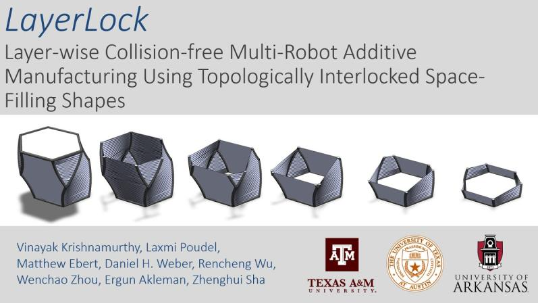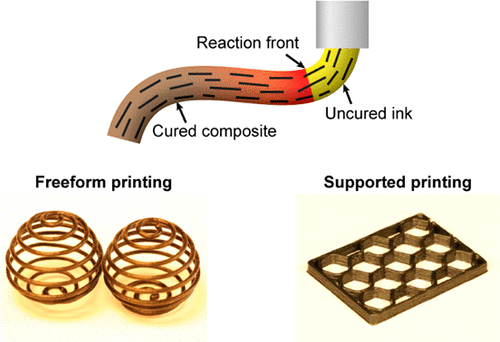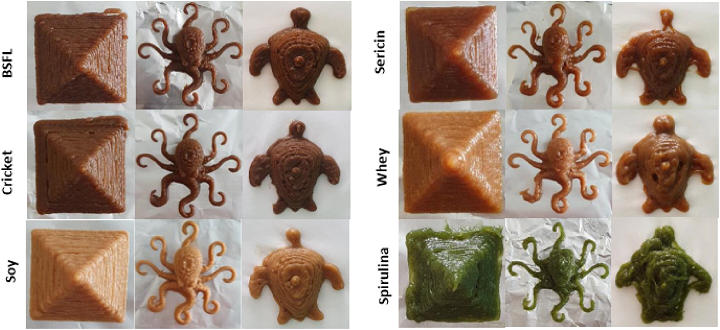The Additive Manufacturing Coalition has announced its newest member; this is what we’re starting off with in today’s 3D Printing News Briefs. Moving on, orders for GE Aerospace’s partially 3D printed engines are high. In research, a multi-university team is working on synchronous multi-robot additive manufacturing, and researchers from Colorado State University are 3D printing carbon fiber composites in a short amount of time, but with minimal heat. Finally, researchers from Singapore and China came up with an approach to incorporate alternative proteins, like crickets, into food inks.
SLM Solutions Joins Additive Manufacturing Coalition
The Additive Manufacturing Coalition, the national nonprofit recognized as the voice for AM with decision-makers and stakeholders, announced that SLM Solutions is its newest Member. With its US headquarters in Michigan, SLM Solutions invented the selective laser melting (SLM) process, and provides its integrated, multi-laser, metal AM solutions to customers around the world in major industries, including automotive, aerospace, aviation, energy, defense, and health sciences. The company is focused on developing and distributing the most production-oriented metal 3D printing systems, with a global install base of about 750, and will help to drive the federal government’s vision for additive manufacturing.
“Having SLM Solutions as a member brings a new voice to our Coalition when we’re speaking to decisionmakers in Washington, DC about additive manufacturing,” said David Cherington, Executive Director of the Additive Manufacturing Coalition. “As the company which invented the selective laser melting process and how that process is expanding the possibilities for AM [additive manufacturing], SLM Solutions helps to define the possibilities for AM now and into the future.”
Orders Spike for Partially 3D Printed Engines by GE Aerospace
GE Aerospace, formerly GE Aviation, reports that the demand and number of orders for its partially 3D printed engines has spiked, helping to boost its revenues by 27% last quarter. This GE division uses AM to produce its fuel nozzles, which are said to improve fuel consumption by 15%, and 3D prints other components that support the overall product. GE has seen growth in its aerospace and aviation division, particularly with its engine hardware and services, and this growth was partially supported by a deal with Boeing, which will have GE engines used on the 737-10 in Delta and Qatar Airways aircraft.
In its recent financial reports, GE indicates that 3D printing product advancements could continue to drive further revenue growth; for instance, its partially 3D printed Avio Aero Catalyst engine will be used in the Airbus Eurodrone surveillance vehicle. Last year, GE Aerospace made the switch from casting to metal 3D printing for four turbine parts, and its Singapore MRO facility is the first to be approved to use metal additive manufacturing for commercial jet engine component repairs.
Collision-Free Multi-Robot Additive Manufacturing
A collaborative team of researchers from Texas A&M University (TAMU), University of Michigan, University of Texas at Austin (UT Austin), and University of Arkansas developed a unique approach for collaborative 3D printing robots (synchronous multi-robot AM). Their method is outlined in a published paper, titled “LayerLock: Layer-Wise Collision-Free Multi-Robot Additive Manufacturing Using Topologically Interlocked Space-Filling Shapes,” and is based on a class of topologically interlocked shapes called Delaunay Lofts. These shapes come about by, as they explained, “stacking layers of Voronoi partitions of a set of moving Voronoi sites based on wallpaper symmetries.” The team developed an algorithm for volume-partitioning, cell sequencing, and path planning for a two-robot AM system, which is then numerically evaluated for parameters like cell resolution and part orientation. They demonstrated their approach by using the two-robot system to 3D print topologically interlocked space-filling structures.
“Our approach is based on two key insights. First, each layer of a Delaunay Loft is simply a tessellation of convex polygons allowing for easy division of cells for collision-free simultaneous material deposition. Second, the unique transition of Voronoi cells along the layers naturally leads to topological interlocking, thereby providing better energy absorption ability compensating for the loss of structural strength due to segmented printing,” the abstract states. “In this work, we constrain our current investigation to a two-robot system and develop the LayerLock algorithm consisting of three steps: (1) a distance-based division of the Voronoi cells at each layer of the Delaunay Loft, (2) a moving-front strategy for determining the sequence of cells for each robot, and (3) print path generation based on the cell sequence, which allows synchronous collaboration.”
3D Printing Free-Form Carbon Fiber-Reinforced Materials
Research out of Colorado State University‘s mechanical engineering department is focused on freeform 3D printing of carbon fiber-reinforced material—specifically thermoset polymer composites. The material is lightweight but strong, and the researchers are said to be among the first in the world to complete this type of composite 3D printing, where the material hardens on its own as it unfolds on a heated surface, without the use of a mold or support structure. The technique combines both freeform and layer-by-layer 3D printing strategies, without the need for a post-curing step. Together with two graduate students, Mostafa Yourdkhani, assistant mechanical engineering professor in the Walter Scott, Jr. College of Engineering, published a paper on the work, which details the 3D printing of carbon fiber composites with minimal heat in a very short amount of time. This could result in a reduction time, energy, and cost for producing this kind of complex structure.
“3D printing of fiber-reinforced thermoset composites is desirable for rapid fabrication of 3D composite objects with minimal tooling. One of the main issues in 3D printing of thermoset composites is the low cure rates of matrix resins, which prevents rapid curing and rigidization of composite materials during the printing process and capturing the desired print geometry,” the abstract states. “Here, we demonstrate a new technique for in situ printing and curing of carbon-fiber-reinforced thermoset composites without any postcuring or postprocessing steps. Upon extrusion and deposition of the composite ink from a printing nozzle, the ink is cured via frontal polymerization, leading to rapid printing of high-quality composites. Tailoring the processing conditions allows for freeform or rapid, supported printing of 3D composite objects with zero void content and highly oriented carbon fiber reinforcements.”
3D Printing Food Inks with Alternative Proteins
Finally, while people in some parts of the world are more used to consuming alternative protein sources, like algae, insects, and plants, it’s an uncomfortable thought for many. But as the population continues to grow, so too is the demand for protein-rich food, which is raising concerns about increased land and water consumption, as well as greenhouse gases. A team of researchers from Singapore University of Technology and Design (SUTD), the University of Electronic Science and Technology of China (UESTC), Nanyang Technological University, and Khoo Teck Puat Hospital are working together to make the idea of alternative proteins, such as crickets, more palatable by mixing them with common foods, like carrots, to create an extrudable ink for 3D printing appealing shapes and textures. This type of work is typically done using trial and error, but this team developed a systematic engineering approach—based on established Response Surface Methodology—that can more efficiently incorporate alternative proteins into food inks. In their study, they explain how they used the central composite design approach to optimize the different formulations, and experimented with proteins like soy, sericin, cricket, and black soldier fly larvae.
“This research study can also be generalised for other food ingredients and response of the food inks like texture, printability, water seepage may be included for optimization,” explained Aakanksha Pant, SUTD research associate and a corresponding author of the study. “The response surface method approach may lead researchers to adopt similar method for optimizing 3DFP food inks constituting complex multicomponent food ingredients.”
Subscribe to Our Email Newsletter
Stay up-to-date on all the latest news from the 3D printing industry and receive information and offers from third party vendors.
You May Also Like
Precision at the Microscale: UK Researchers Advance Medical Devices with BMF’s 3D Printing Tech
University of Nottingham researchers are using Boston Micro Fabrication‘s (BMF) 3D printing technology to develop medical devices that improve compatibility with human tissue. Funded by a UK grant, this project...
3D Printing Webinar and Event Roundup: April 21, 2024
It’s another busy week of webinars and events, starting with Hannover Messe in Germany and continuing with Metalcasting Congress, Chinaplas, TechBlick’s Innovation Festival, and more. Stratasys continues its advanced training...
3D Printing Webinar and Event Roundup: March 17, 2024
It’s another busy week of webinars and events, including SALMED 2024 and AM Forum in Berlin. Stratasys continues its in-person training and is offering two webinars, ASTM is holding a...
3D Printed Micro Antenna is 15% Smaller and 6X Lighter
Horizon Microtechnologies has achieved success in creating a high-frequency D-Band horn antenna through micro 3D printing. However, this achievement did not rely solely on 3D printing; it involved a combination...


































